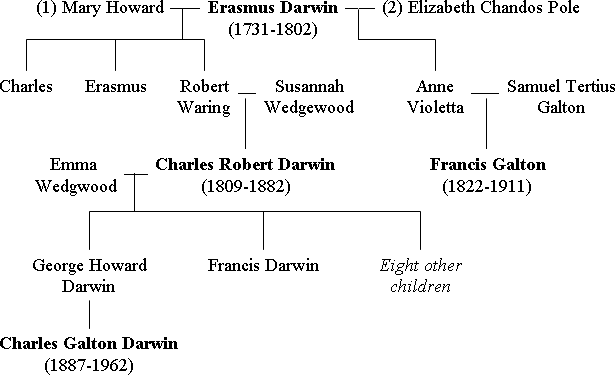Erasmus Darwin
|
|
Erasdarwin1.jpg
Darwin_cutout.gif
Erasmus Darwin (December 12,1731 – April 18,1802) trained as a physician and wrote extensively on medicine and botany, as well as poetry. Living in Birmingham and Lichfield, England. He was one of the founder members of the Lunar Society. He was a member of the Darwin-Wedgwood family, most famously including his grandson, Charles Darwin.
He was born near at Elston Hall near Nottingham. he was educated at Chesterfield School then later at St. John's College, Cambridge. He obtained his degree at Edinburgh Medical School. He settled in 1756 as a physician at Nottingham, but meeting with little success he moved in the following year to Lichfield. He practised medicine in Lichfield in Staffordshire for twenty years; George III invited him to be royal physician but he declined. In 1781 he moved to Derby, where he died suddenly on the 18th of April 1802.
| Contents |
Zoönomia
His most important scientific work is his Zoönomia (1794–1796), which contains a system of pathology, and a treatise on "generation," in which he, in the words of his famous grandson, Charles Robert Darwin, anticipated the views of Jean-Baptiste Lamarck, who in turn is regarded to have foreshadowed theory of evolution. The essence of his views is contained in the following passage, which he follows up with the conclusion that one and the same kind of living filaments is and has been the cause of all organic life:
- Would it be too bold to imagine that, in the great length of time since the earth began to exist, perhaps millions of ages before the commencement of the history of mankind would it be too bold to imagine that all warm-blooded animals have arisen from one living filament, which the great First Cause endued with animality, with the power of acquiring new parts, attended with new propensities, directed by irritations, sensations, volitions and associations, and thus possessing the faculty of continuing to improve by its own inherent activity, and of delivering down these improvements by generation to its posterity, world without end!
Zoönomia is widely considered to foreshadow the pre-Darwinian theories of Jean-Baptiste Lamarck, and maybe even the theory of evolution formulated by his grandson Charles Darwin. Another of his grandsons was Francis Galton.
Big Bang and Big Crunch Cosmological Theories
Contemporary literature dated the cosmological theories of the Big Bang and Big Crunch to the 19th and 20th centuries, however Erasmus Darwin had documented them much earlier. Here is a passage from Darwin's The Botanic Garden, A Poem in Two Parts: Part 1, The Economy of Vegetation, 1791:
Roll on, ye Stars! exult in youthful prime,
Mark with bright curves the printless steps of Time;
Near and more near your beamy cars approach,
And lessening orbs on lessening orbs encroach; -
Flowers of the sky! ye too to age must yield,
Frail as your silken sisters of the field!
Star after star from Heaven's high arch shall rush,
Suns sink on suns, and systems systems crush,
Headlong, extinct, to one dark center fall,
And Death and Night and Chaos mingle all!
- Till o'er the wreck, emerging from the storm,
Immortal Nature lifts her changeful form,
Mounts from her funeral pyre on wings of flame,
And soars and shines, another and the same.
Family Tree
His experiments in galvanism inspired Mary Shelley to write Frankenstein. His poetry was admired by Coleridge and Wordsworth; and often made reference to his interests in science, for example botany and steam engines. His most famous work of poetry was The Botanic Garden.
He is remembered by the Moonstones in Birmingham.
Inventions
He was in inventor of several devices, though did not patent any of them. He believed this would damage his reputation as a doctor, and encouraged his friends to patent their own modifications of his designs.
- One was a horizontal windmill, which he designed for Josiah Wedgwood (who would be Charles Darwin's other grandfather).
- A carriage that would not tip over was designed in 1766.
- In 1771 he invented a speaking machine;
- A canal lift for barges;
- A minute artificial bird.
- In 1778 he came up with a copying machine;
- He also produced a variety of weather monitoring machines.
- In 1783 he invented an artesian well.
- He conducted research into the formation of clouds, the latter of which he published in 1788.
Quotations
Organic life beneath the shoreless waves
Was born and nurs'd in ocean's pearly caves;
First forms minute, unseen by spheric glass,
Move on the mud, or pierce the watery mass;
These, as successive generations bloom,
New powers acquire and larger limbs assume;
Whence countless groups of vegetation spring,
And breathing realms of fin and feet and wing.
For if we may compare infinities, it would seem to require a greater infinity of power to cause the causes of effects, than to cause the effects themselves. This idea is analogous to the improving excellence observable in every part of the creation; such as in the progressive increase of the solid or habitable parts of the earth from water; and in the progressive increase of the wisdom and happiness of its inhabitants; and is consonant to the idea of our present situation being a state of probation, which by our exertion we may improve, and are consequently responsible for our actions.
External links
- "Preface and 'a preliminary notice'" by Charles Darwin (http://pages.britishlibrary.net/charles.darwin3/erasmus.html) in Ernst Krause, Erasmus Darwin (1879)
"Zoonomia, Vol. I Or, the Laws of Organic Life" (http://ahistory.eotalk.com)de:Erasmus Darwin ja:エラズマス・ダーウィン ru:Дарвин, Эразм

